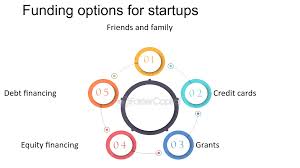Launching and scaling a startup or small business in the US is both exciting and challenging—especially when it comes to funding. In 2025, entrepreneurs have more options than ever before, ranging from traditional loans to innovative fintech solutions. This guide breaks down the top 10 funding options for US startups and small enterprises to help you choose the right path to fuel your business growth.
- Post
- Image
Notifications
Drag and drop an image, upload, or choose from your library.CopyCtrl+CCutCtrl+XDuplicateCtrl+Shift+DAdd beforeCtrl+Alt+TAdd afterCtrl+Alt+YCopy stylesPaste stylesGroupLockRenameCreate patternSet as featured imageEdit as HTMLDeleteShift+Alt+ZSelect FilesSelect Files
 Funding Options for US Startups
Funding Options for US Startups
1. SBA Loans (Small Business Administration Loans)
SBA loans remain a top choice in 2025 due to their favorable terms and government backing. Options like the SBA 7(a) and 504 loans offer low interest rates, long repayment terms, and can be used for everything from working capital to real estate.Funding Options for US Startups
Best For: Established businesses with good credit seeking long-term financing.
2. Angel Investors
Angel investors provide capital in exchange for equity and are often more flexible than venture capitalists. In 2025, angel networks are becoming more niche-specific, helping startups find investors aligned with their industry and mission.Funding Options for US Startups
Best For: Early-stage startups with a compelling idea and a scalable business model.
3. Venture Capital (VC)
Venture capital is ideal for high-growth startups looking to scale quickly. In 2025, sectors like AI, clean tech, and healthtech are particularly attractive to VC firms. However, be prepared to give up equity and maintain strong performance expectations.Funding Options for US Startups Funding Options for US Startups
Best For: Startups with a proven business model and high growth potential.
4. Crowdfunding Platforms
Platforms like Kickstarter, Indiegogo, and Republic allow entrepreneurs to raise money directly from the public. This approach doubles as a marketing tool, helping build a customer base before the product even launches.Funding Options for US Startups
Best For: Consumer products and creative ventures that can build public excitement.
5. Business Lines of Credit
A business line of credit offers flexible access to funds up to a certain limit and is ideal for managing cash flow or short-term expenses. Fintech lenders in 2025 provide fast approval and funding, often within 24 hours.
Best For: Businesses that need on-demand access to working capital.
6. Equipment Financing
Need to purchase heavy equipment or machinery? Equipment financing allows you to buy what you need without upfront capital. The equipment itself usually serves as collateral, making this option accessible even to newer businesses.
Best For: Construction, manufacturing, or logistics startups.
7. Government Grants and Subsidies
Federal and state-level grants remain a strong non-dilutive funding option. In 2025, the Small Business Innovation Research (SBIR) program and Minority Business Development Agency (MBDA) offer grants for research, development, and minority-owned enterprises.
Best For: Tech, research-based, or underrepresented founders.
8. Revenue-Based Financing
In this model, businesses receive upfront capital and repay it based on a percentage of their monthly revenue. This is gaining popularity in 2025 for SaaS and subscription-based businesses.
Best For: Startups with consistent revenue streams but limited assets or collateral.
9. Peer-to-Peer Lending (P2P)
P2P lending connects borrowers directly with investors via online platforms like LendingClub or Funding Circle. It’s often faster and more accessible than traditional bank loans, especially for founders with less-than-perfect credit.
Best For: Founders seeking fast approval with fewer traditional banking hurdles.
10. Bootstrapping with Strategic Partnerships
While not a “funding source” in the traditional sense, bootstrapping combined with partnerships can go a long way. In 2025, many startups collaborate with other companies to share resources, reduce costs, and co-develop products.
Best For: Founders looking to retain full ownership and grow steadily.
Conclusion
In 2025, funding options for US startups are more varied and accessible than ever. The right choice depends on your business stage, financial goals, and risk tolerance. Whether you’re looking for equity-free capital or planning to scale rapidly with investor support, there’s a funding path tailored to your journey.
Be sure to research each option thoroughly, and if needed, consult with a financial advisor to map out the best route for your business success.
